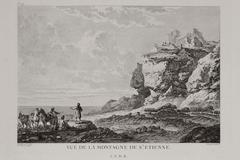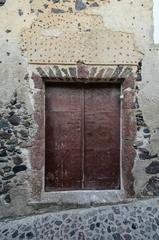
Ancient Thera Visiting Hours, Tickets, and Comprehensive Travel Guide
Date: 14/06/2025
Explore Ancient Thera: Santorini’s Archaeological Marvel
Perched high atop the commanding Mesa Vouno ridge on the island of Santorini, Ancient Thera is a testament to over 1,500 years of Aegean civilization. Founded by Dorian settlers in the 9th century BCE, this extraordinary site offers a rare glimpse into the evolution of Greek, Roman, and Byzantine cultures. Visitors will discover well-preserved ruins—including temples, a theatre, an agora, sanctuaries, and residential quarters—set against breathtaking panoramic views of the Aegean Sea. Whether you are a history enthusiast or a curious traveler, this guide presents everything you need to plan your visit: from Ancient Thera’s visiting hours and ticket prices to travel tips, accessibility, and nearby attractions. Dive into the rich history and vibrant legacy of this essential Santorini destination (Wikipedia, Santorini Experts, akrotiri-museum.com).
Table of Contents
- Introduction
- Historical Overview
- Site Layout and Key Features
- Visiting Ancient Thera: Practical Information
- Travel Tips and Safety
- Nearby Attractions
- FAQ
- Conclusion
Introduction
Ancient Thera is one of Santorini’s most compelling archaeological sites, where history, culture, and stunning natural beauty converge. Situated atop Mesa Vouno, between the villages of Kamari and Perissa, the site offers visitors a journey through the island’s storied past and panoramic vistas of the Aegean. This guide provides up-to-date information on Ancient Thera visiting hours, tickets, accessibility, and travel recommendations to ensure a rewarding visit.
Historical Overview
Foundation and Early Development
Founded in the 9th century BCE by Dorian settlers from Sparta, Ancient Thera was named after their legendary leader, Theras. Its strategic mountaintop location provided natural defenses and facilitated control over sea routes, shaping the city’s enduring importance (Wikipedia; Santorini Experts). Early settlement evidence includes Cycladic, Minoan, and Mycenaean influences, with artifacts attesting to regional connections (akrotiri-museum.com).
Urban Expansion and Hellenistic Period
Thera flourished during the Hellenistic period (4th–1st centuries BCE), especially under the Ptolemaic dynasty. The city expanded with a structured grid plan, agora, stoa, theatre, gymnasium, and sanctuaries. The theatre, carved into the mountain’s slope, and the agora, the heart of civic life, reflect architectural sophistication and the city’s cultural vibrancy (Shiny Greece).
Roman and Byzantine Eras
Under Roman rule, Thera continued to thrive, adopting Roman architectural styles and constructing new public buildings. Christianity’s arrival is marked by early basilicas, such as the Basilica of Agios Stefanos. The city remained a regional center until the 8th century CE, when volcanic eruptions led to its abandonment (Santorini Dave; Santorini Experts).
Decline and Rediscovery
The eruption of 726 CE buried the city in volcanic pumice, leading to its decline and abandonment. Systematic excavations began in the late 19th century, revealing extensive ruins, inscriptions, statues, and everyday artifacts that now illuminate the life and legacy of Ancient Thera (akrotiri-museum.com; Wikipedia).
Site Layout and Key Features
Agora and Stoas
The agora served as Ancient Thera’s commercial and administrative hub. Remnants of colonnaded stoas and marketplaces line the stone-paved square, where merchants and citizens once gathered (akrotiri-museum.com).
Theatre and Public Buildings
The Hellenistic-era theatre, facing the sea, could seat over 1,500 spectators for dramatic and civic events, and remains one of the site’s most photogenic spots. Other public buildings include the basilike stoa and gymnasium, underscoring the city’s civic and athletic life.
Residential Areas
Houses constructed with local volcanic stone are scattered throughout the site, many retaining original floor plans and decorative elements such as mosaics and painted plaster. The narrow, winding streets reflect adaptation to the rugged terrain.
Temples and Sanctuaries
Thera’s religious life is evident in sanctuaries dedicated to Greek and Egyptian deities:
- Sanctuary of Artemidoros: Carved into the rock with reliefs and inscriptions.
- Temple of Dionysus: Near the agora, celebrating the god of wine.
- Sanctuary of Apollo Karneios: A focal point for Dorian religious practice.
Gymnasium and Baths
The gymnasium and public baths highlight the city’s commitment to athletic training and communal hygiene.
Visiting Ancient Thera: Practical Information
Location and Access
Ancient Thera is located atop Mesa Vouno between Kamari and Perissa. You can access the site by:
- Car: Drive up the winding paved road from Kamari. Limited parking is available at the summit; arrive early during peak season.
- Hiking: Scenic trails ascend from both Kamari and Perissa (each taking about 45–60 minutes). The Kamari route is less steep and more gradual, while Perissa’s path is steeper and more challenging (Thera Foundation).
Opening Hours and Tickets
- April to October: Open daily from 08:00–20:00 (last entry 20 minutes before closing).
- November to March: Reduced hours, typically 08:00–15:00.
- Closed: Mondays and major Greek holidays (January 1st, March 25th, December 25th–26th).
- Admission: €6 for adults; €3 for students, seniors, and certain EU citizens. Children under 18 enter free (Visit Our Greece).
- Free Admission Days: International Monuments Day (April 18), International Museums Day (May 18), last weekend of September (European Heritage Days), national holidays, and first Sundays from November to March.
- Tickets: Purchase on-site (cash or credit card); check for online options via official portals.
Accessibility and Facilities
- Physical Accessibility: The site is largely uneven with steep paths and rocky surfaces, unsuitable for wheelchairs and difficult for those with limited mobility (Thera Foundation).
- Facilities: No restrooms on-site—use facilities in Kamari or Perissa before hiking. A snack van may be present near the entrance, but bringing your own water and snacks is advised.
- Shade and Seating: Limited shade and few benches; sun protection is essential.
Guided Tours and Special Events
Local operators offer guided tours that enrich your understanding of the site’s history and significance. Cultural events and archaeological presentations occasionally take place during heritage days—check local tourism sources for schedules.
Best Times to Visit
- Time of Day: Early morning or late afternoon to avoid heat and crowds.
- Season: Spring (April–June) and autumn (September–October) for comfortable temperatures and fewer visitors.
Travel Tips and Safety
- Wear sturdy shoes and comfortable clothing.
- Bring 1–2 liters of water per person, sunhat, sunglasses, and sunscreen.
- Pack light snacks.
- Observe all safety signs and stay on marked paths.
- Carry out all trash; respect the archaeological remains.
Nearby Attractions
- Archaeological Museum of Thera: Located in Fira, housing many artifacts from Ancient Thera (Visit Our Greece).
- Akrotiri Archaeological Site: Explore Santorini’s prehistoric city (Santorini Wiki).
- Kamari and Perissa: Black sand beaches, local dining, and accommodation options.
Frequently Asked Questions (FAQ)
Q: What are Ancient Thera’s visiting hours?
A: Open 08:00–20:00 in summer, reduced hours in winter, closed Mondays and major holidays.
Q: How do I buy tickets?
A: Purchase on-site with cash or card; check official sites for online options.
Q: Is the site child-friendly?
A: Children can visit but must be supervised due to steep and uneven terrain.
Q: Are there restroom facilities?
A: No restrooms at the site; use facilities in Kamari or Perissa.
Q: Is Ancient Thera accessible for visitors with limited mobility?
A: The site is challenging for those with mobility issues due to rough terrain.
Q: Are guided tours available?
A: Yes, check ahead with local operators or tourist offices.
Q: Can I use a drone for photography?
A: Drone usage may be restricted; check local regulations.
Visuals and Interactive Media
Internal Links
Conclusion
Ancient Thera stands as a remarkable window into Santorini’s layered past, offering an unparalleled blend of archaeological marvels and scenic beauty. With clear guidance on visiting hours, tickets, and travel logistics, you can enjoy a safe, enriching, and memorable visit. Don’t miss the chance to pair your trip with nearby sites like the Archaeological Museum of Thera and Akrotiri for a deeper dive into the island’s heritage. For the latest updates, guided audio tours, and travel inspiration, download the Audiala app and follow Santorini’s historical sites on social media. Make your journey to Ancient Thera an unforgettable highlight of your Santorini adventure.

